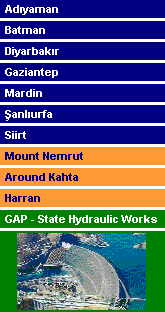| Gaziantep... |
|
Gaziantep is one of the modern provinces of the region and also one of the oldest of Hittite origin. Being the center of
pistachio nut cultivation in Türkiye and with its extensive olive groves and vineyards, Gaziantep is one of the important,
industrial centres of Türkiye. In the center of the city stands the Gaziantep Fortress and the Ravanda citadel as the
reminders of past. The Archaeological Museum, with its important collections from neolithic and the Hittite ages as well
as the Roman and Commagene times, attracts many visitors. The surroundings of the city are also full of valuable Hittite
remains. The Suzer House, which has been restored to its original beauty, now houses the Ethnographical Museum. The Yesemek
Sculpture Workshop, 30 km south of the town of Islahiye, is one of the world's first of this kind. Some of the other
historical remains are the Belkis, and Kargamis Ruins by the town of Nizip. Dulluk which is close to the city center is
ideal for those who would like to rest in a natural setting amidst forest and has camping facilities. The citadel was first
constructed, as far as is known, by the Emperor Justinian in the 6th century AD, but was rebuilt extensively by
the Seljuks in the 12th and 13th centuries. The massive doors to the fortified enclosure may well be
locked, but at least have a look at them. As you approach the kale bear right around the massive walls. Around to the right
of the fosse you will come to a small mosque, opposite which is a ramp leading up to the citadel doors. If they are open,
proceed across the wooden bridge which spans the fosse and into the kale. Gaziantep is famous for its three regional
specialties. First is the copper-ware products you will not want to pass up. The delicious lahmacun (a kind of pizza) is
the second, while the third is the sweet pastry baklava, which Gaziantep makes the best in the world. To travel along
Türkiye's southern border, take the highway which connects Gazi Antep, SanliUrfa and Mardin to Syria and Iraq. Gazi Antep,
located on a wide and fertile plain cultivated with extensive olive groves and vineyards, produces a variety of agricultural
crops. It is especially known throughout Türkiye for its excellent pistachios. Industry also contributes to the local economy.
The 36 towers of the city's fortress were originally constructed in the Justinian era and were later rebuilt by the Seljuks.
The Archaeology Museum has important items from Neolithic, Hittite and Roman times. The Hasan Suzer House, from the turn of
the century, has been beautifully restored and houses the Ethnographical Museum.
|
|

|


 342...
342...
 27...
27...
 1,293,849...
1,293,849...
 6,000...
6,000...
 37 E 22 - 37 N 05...
37 E 22 - 37 N 05...



